Picture this: a storm is brewing, and you notice a large tree in your yard leaning precariously. What do you do? There are reasons you need emergency tree removal services, and these services can save lives and property as well as prevent further damage to your landscape.
In this blog post, we’ll explore the warning signs that call for emergency tree removal in Alpharetta, GA, the dangers of diseased and dead trees, and how to deal with trees near power lines. We’ll also delve into the silent threat of weakened roots and the benefits of emergency tree removal when selling your property. Stay with us until the end; your safety, property, and peace of mind are at stake!
Key Takeaways on Emergency Tree Removal
• Warning signs such as leaning trees, exposed roots, and damaged trunks require immediate attention from certified arborists to prevent escalating costs and ensure safety.
• Diseased or dead trees can spread disease, cause branches to fall, and cause property damage. Emergency removal is necessary for power line proximity.
• Emergency tree removal can increase a property’s value by addressing hazards, improving landscape appearance & speeding up the sale process.
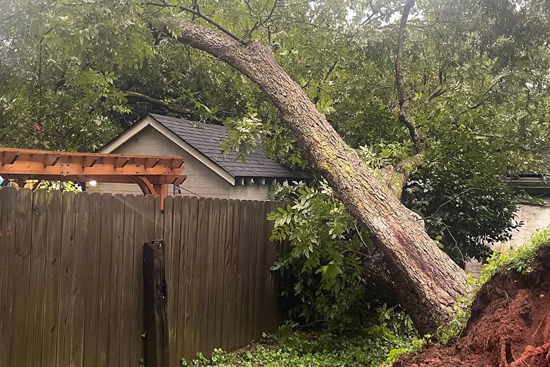
1. Warning Signs That Call for Emergency Tree Removal
Trees are beautiful and provide numerous benefits, but they can also pose risks if not properly maintained. Some warning signs that call for emergency tree removal include leaning trees, exposed roots, and damaged trunks, which can all jeopardize your property and safety. Prompt attention to these issues will prevent escalating tree removal costs.
Certified arborists, equipped with the necessary gear and experience, will safely provide tree removal service without causing damage, thereby protecting your property.
We will examine these warning signs and the associated risks in more detail.
Leaning Trees
A leaning tree is a telltale sign of weak roots and a potential danger to property, especially during high winds or storms. A tree with a lean of more than 15 percent should be assessed by a professional to determine if it poses a safety risk.
Leaving a branch hanging dangerously close to your home’s structure may result in damage to the roof, windows, and other parts of the home, affecting the ability of nearby trees to remain healthy. Regular tree service can help you spot leaning trees early, allowing you to take necessary action before disaster strikes.
Exposed Roots
Exposed roots are another warning sign that requires attention. Tree roots visible above the ground can result from soil erosion, improper planting, or other environmental factors. The roots of these plants can cause severe and costly damage. They can undermine your home’s foundation and lift patio stones, walkways, and driveways.
Upon spotting unhealthy, weakened, or decaying exposed roots, immediate contact with a tree service is recommended.
Damaged Trunks
A tree with a damaged trunk, such as a cavity or missing bark, can also pose a risk. Cavities in the trunk can compromise the tree’s structure and increase the likelihood of falling, leading to extensive property damage and potential harm to individuals.
Moreover, cavities provide an ideal environment for pests and diseases to spread, resulting in the rapid death of the tree. A professional assessment is advised upon noticing a damaged trunk, as it helps determine the necessity of tree removal.
2. The Dangers of Diseased and Dead Trees
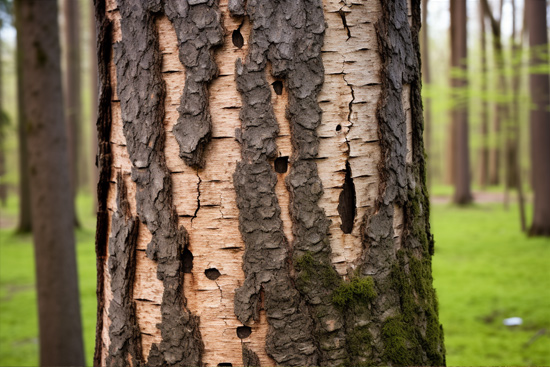
Diseased and dead trees are more than just an eyesore; they can be a ticking time bomb. These trees can spread disease to surrounding trees, cause falling branches, and even lead to property damage. Responsibility as a property owner entails vigilance in identifying signs of tree disease and implementing appropriate action.
Next, we will delve into the hazards of diseased and dead trees and the ways to mitigate them.
Disease Spread
Diseased trees can infect nearby trees and plants, leading to a more significant problem. Some indications of a diseased tree include:
• Oozing wounds or cankers on the trunk
• Sunken bark areas
• Insect infestations
• Bark cracks
• Swollen areas
Promptly removing diseased trees is vital to ensure that the surrounding trees remain healthy, preventing the spread of disease and protecting the health of your landscape.
Falling Branches
Dead or dying branches can fall and cause injury or damage to property. Discoloration, cracks, or missing bark can help you identify dead or dying branches.
Regular tree assessments for signs of deterioration and prompt trimming or removal of dead or deteriorating branches are crucial in avoiding falling branches.
Property Damage
Diseased or dead trees can pose a risk to structures and vehicles if they fall. High winds, heavy ice, and snow accumulation are some of the primary causes of property damage from trees.
Homeowners insurance may provide coverage for tree damage caused by windstorms, lightning, or hail. Promptly addressing diseased and dead trees is a critical measure in minimizing the risk of property damage.
3. Power Line Proximity: A Risky Situation
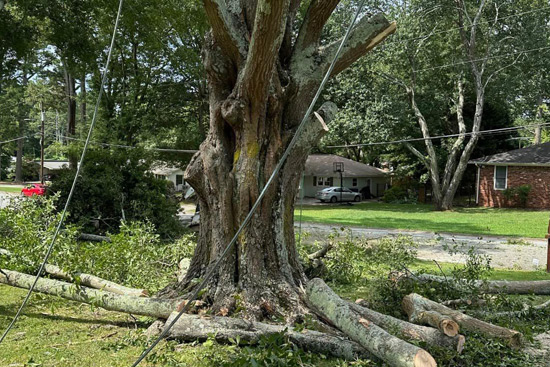
Trees near power lines can create dangerous situations and require professional trimming or emergency removal. We will explore the dangers trees pose near power lines and emphasize the importance of maintaining a safe distance.
Power lines can be a hazard to trees, as they can cause electrical arcing and fires.
Safe Distance
It’s recommended that trees should always remain at least 10 feet from a power line. A safe distance between trees and power lines helps prevent power outages and wildfires.
Regular inspections and pruning can help ensure that trees maintain a safe distance from power lines.
Professional Trimming
Professional trimming is necessary for trees near power lines to maintain a safe distance. Engaging professional tree trimming services can promote the health and aesthetic of the trees, as well as decrease the likelihood of potential damage to property or power lines.
Emergency Removal
Dying or dead trees near power lines should be removed immediately to prevent potential hazards.
Emergency tree removal is typically required when a tree is leaning, has exposed roots, is damaged, is diseased or dead, or has been impacted by a storm. In such cases, an emergency tree service can provide the necessary assistance, like an emergency tree removal service.
4. Storm Damage and Emergency Tree Services
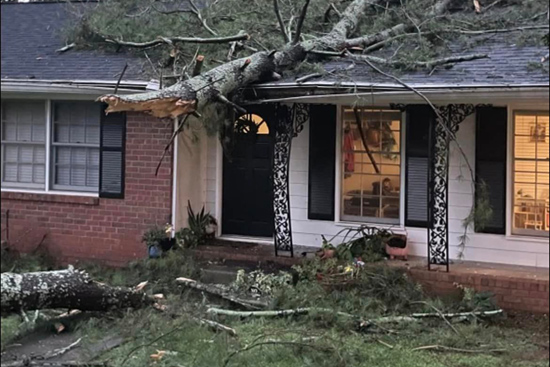
Storms can wreak havoc on trees, leading to broken branches and fallen trees requiring emergency services. We will now discuss the effects of storm damage on trees and the role of emergency tree care in addressing these problems.
Broken Branches
Broken branches from storms can pose a risk to property and safety and should be removed by professionals.
Regular tree inspections and pruning can help identify and address broken branches and other issues with tree branches before they become a hazard.
Fallen Trees
Fallen trees can cause damage to property, block roads, or injure people, necessitating emergency tree removal services. Trees may fall during a storm due to strong winds or soil saturation, leading to root slippage or internal decay.
Regular tree maintenance can help prevent tree falls and minimize the risk of property damage.
5. Weakened Roots: A Silent Threat
Weakened tree roots can cause instability, leading to potential damage or injury, and may require emergency tree removal or saving measures.
Next, we will discuss the risks posed by weakened roots, the indications of root damage, and strategies for addressing tree instability.
Root Damage
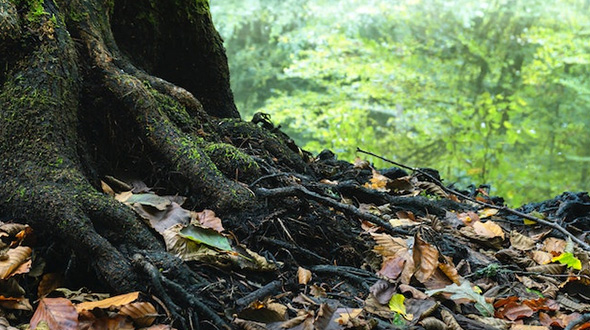
Root damage can result from various factors, such as disease, pests, or construction. Some indicators of root damage include discolored or wilted leaves, dead branches, and mushrooms growing near the tree’s base.
Root damage can result in tree instability, potentially leading to the tree falling resulting in property damage. To prevent root damage, ensure adequate drainage, aeration, and nutrient supply to the soil, and avoid activities that might cause damage to the roots, such as construction or excavation.
Tree Instability
Tree instability can be caused by site disturbance, alteration of the center of gravity during storms, defects, inadequate maintenance, injury to the lower trunk, and damage to the root system.
An examination is advised if a significant portion of a tree’s roots are exposed. Regular inspections can help identify tree instability and allow homeowners to act appropriately to prevent property damage or injury.
Saving Measures
In some cases, trees with weakened roots can be saved through proper care and maintenance. Steps to save a tree with weakened roots include:
• Watering the tree regularly
• Mulching around the base of the tree
• Providing adequate nutrients
• Pruning the tree to reduce weight on the weakened roots
Regular tree care can help strengthen weakened roots and prevent further damage.
6. The Benefits When Selling Your Property
Emergency tree removal can be a valuable investment when selling your property. By addressing potential hazards and improving the appearance of your landscape, you can increase property value, enhance curb appeal, and achieve a faster sale.
Now, let’s delve into the benefits of emergency tree removal for property sellers.
Increased Property Value
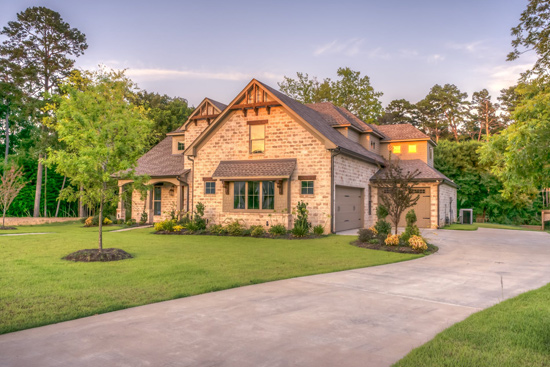
Trees and branches that are removed can have a positive impact on property values. Some benefits include:
• Increased property value for homes (up to 7%) and building lots (up to 18%)
• More usable outdoor space
• Enhanced curb appeal
• Better views and vantage points
• Increased energy efficiency
• Reduced risk of injury and property damage
Enhanced Curb Appeal
Healthy trees and well-maintained landscapes can improve curb appeal and attract potential buyers. Some benefits of emergency tree removal include:
• Improved aesthetics
• Increased safety
• Prevention of property damage
• Control of pests and diseases
A well-kept property with no signs of tree hazards is more appealing to prospective buyers.
Faster Sale
Emergency tree removal can help expedite the sale process by addressing potential hazards and improving the property’s appearance. A property that has been well cared for, with healthy trees and a clean landscape, is more likely to sell quickly and at a higher price.
Avoid letting overgrown, damaged, or diseased trees hinder a successful sale.
Emergency Tree Services Summary
In conclusion, emergency tree removal is a crucial service to ensure your property’s safety and your landscape’s well-being. By recognizing the warning signs and addressing issues promptly, you can protect your property, prevent damage, and even enhance your home’s value and curb appeal. Don’t wait for disaster to strike; invest in professional tree care today and enjoy the peace of mind that comes with a healthy, hazard-free landscape.
Frequently Asked Questions
Why would a tree need to be removed?
The tree’s size, proximity to construction, and potential disease or insect infestation make it necessary to remove it for safety and health reasons.
What are common warning signs that call for emergency tree removal?
Leaning trees, exposed roots, and damaged trunks are warning signs that should not be ignored and often call for emergency tree removal.
How can I prevent tree instability caused by weakened roots?
Taking steps such as proper watering, mulching, and pruning can help strengthen weakened roots and prevent tree instability.
What is the recommended safe distance between trees and power lines?
Trees should be kept at least 10 feet away from power lines to ensure safety.
How can emergency tree removal increase my property value when selling?
Emergency tree removal can improve curb appeal, reduce the risk of injury and property damage, and create more usable outdoor space, making it an attractive selling point that could significantly increase property value.
This article was first published on: https://www.72tree.com/6-reasons-need-emergency-tree-removal-services/